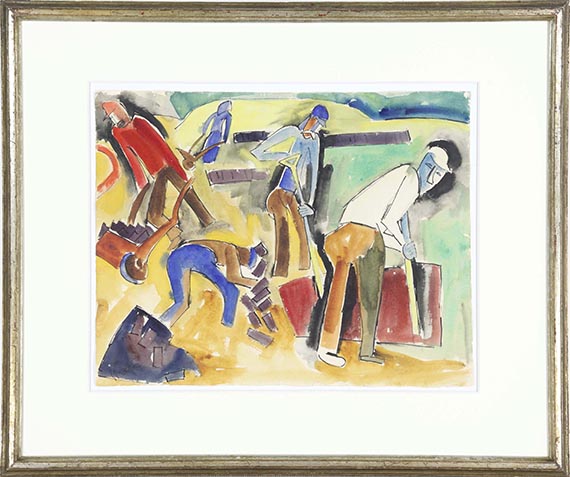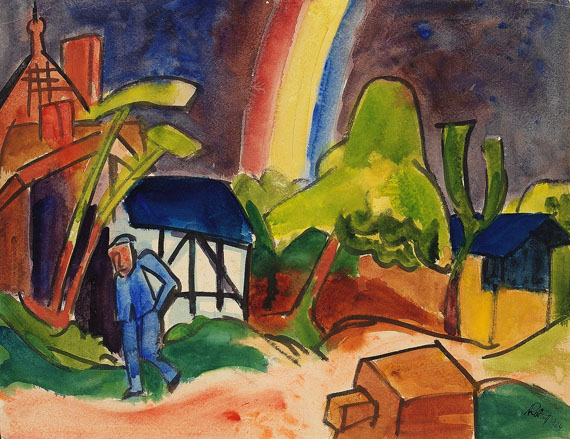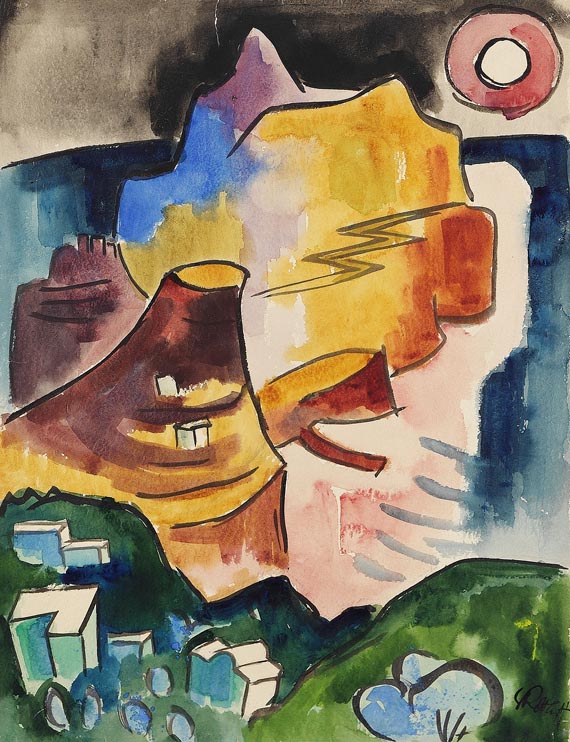425
Karl Schmidt-Rottluff
Beim Torfstechen, 1922.
Watercolor and ink pen
Estimation: € 30,000 / $ 32,100
Beim Torfstechen. 1922.
Watercolor and ink pen.
Lower left signed and dated. Titled on the reverse. On off-white watercolor paper. 47.7 x 60.5 cm (18.7 x 23.8 in), the full sheet. [CH].
• Elaborate, colorful watercolor of painting-like effect.
• In 1989 part of the grand retrospective at the Lenbachhaus in Munich and the Kunsthalle Bremen.
• Using strong colors, peat blocks abstracted into geometric shapes, the arrangement of the peat diggers' dynamic action and the direct gaze of the right figure, Schmidt-Rottluff creates a fascinating composition.
• The artist spent most summers between 1920 and 1931 in Jershöft in Eastern Pommerania on the Baltic Sea, with its characteristic bogs and marsh-lands.
The work is documented in the archive of the Karl and Emy Schmidt-Rottluff Foundation, Berlin.
PROVENANCE: Kunsthütte Chemnitz (1923 - August 19, 1937, with the inventory number on the reverse).
State-owned (confiscated from the above in context of the "Degenerat Art" campaign in 1937, EK no. 17644-E).
Frankfurter Kunstkabinett Hanna Bekker vom Rath, Frankfurt a.M.
Hermann Gerlinger Collection, Würzburg (acquired from the above in 1988, with the collector's stamp, Lugt 6032).
EXHIBITION: Karl Schmidt-Rottluff 1884-1976. Malerei und Graphik - Werke im Besitz der Städtischen Kunstsammlung Karl-Marx-Stadt, Karl-Marx-Stadt 1982, p. 78 (illu.).
Karl Schmidt-Rottluff. Retrospektive, Kunsthalle Bremen, July 16 - September 10, 1989, Städtische Galerie im Lenbachhaus, Munich, September 27 - December 3, 1989, cat. no. 249 (illu., p. 268).
Expressiv! Die Künstler der Brücke. Die Sammlung Hermann Gerlinger, Albertina Vienna, June 1 - August 26, 2007, p. 110, cat. no. 61 (illu.).
LITERATURE: Heinz Spielmann (ed.), Die Maler der Brücke. Sammlung Hermann Gerlinger, Stuttgart 1995, p. 398, SHG no. 693 (illu).
Hermann Gerlinger, Katja Schneider (eds.), Die Maler der Brücke. Inventory catalog Hermann Gerlinger Collection, Halle (Saale) 2005, p. 99, SHG no. 207 (illu.)
www.geschkult.fu-berlin.de/e/db_entart_kunst/datenbank (EK no. 17644-E).
Called up: June 8, 2024 - ca. 17.33 h +/- 20 min.
Watercolor and ink pen.
Lower left signed and dated. Titled on the reverse. On off-white watercolor paper. 47.7 x 60.5 cm (18.7 x 23.8 in), the full sheet. [CH].
• Elaborate, colorful watercolor of painting-like effect.
• In 1989 part of the grand retrospective at the Lenbachhaus in Munich and the Kunsthalle Bremen.
• Using strong colors, peat blocks abstracted into geometric shapes, the arrangement of the peat diggers' dynamic action and the direct gaze of the right figure, Schmidt-Rottluff creates a fascinating composition.
• The artist spent most summers between 1920 and 1931 in Jershöft in Eastern Pommerania on the Baltic Sea, with its characteristic bogs and marsh-lands.
The work is documented in the archive of the Karl and Emy Schmidt-Rottluff Foundation, Berlin.
PROVENANCE: Kunsthütte Chemnitz (1923 - August 19, 1937, with the inventory number on the reverse).
State-owned (confiscated from the above in context of the "Degenerat Art" campaign in 1937, EK no. 17644-E).
Frankfurter Kunstkabinett Hanna Bekker vom Rath, Frankfurt a.M.
Hermann Gerlinger Collection, Würzburg (acquired from the above in 1988, with the collector's stamp, Lugt 6032).
EXHIBITION: Karl Schmidt-Rottluff 1884-1976. Malerei und Graphik - Werke im Besitz der Städtischen Kunstsammlung Karl-Marx-Stadt, Karl-Marx-Stadt 1982, p. 78 (illu.).
Karl Schmidt-Rottluff. Retrospektive, Kunsthalle Bremen, July 16 - September 10, 1989, Städtische Galerie im Lenbachhaus, Munich, September 27 - December 3, 1989, cat. no. 249 (illu., p. 268).
Expressiv! Die Künstler der Brücke. Die Sammlung Hermann Gerlinger, Albertina Vienna, June 1 - August 26, 2007, p. 110, cat. no. 61 (illu.).
LITERATURE: Heinz Spielmann (ed.), Die Maler der Brücke. Sammlung Hermann Gerlinger, Stuttgart 1995, p. 398, SHG no. 693 (illu).
Hermann Gerlinger, Katja Schneider (eds.), Die Maler der Brücke. Inventory catalog Hermann Gerlinger Collection, Halle (Saale) 2005, p. 99, SHG no. 207 (illu.)
www.geschkult.fu-berlin.de/e/db_entart_kunst/datenbank (EK no. 17644-E).
Called up: June 8, 2024 - ca. 17.33 h +/- 20 min.
The artist spent most of the summers between 1920 and 1931 in Jershöft on the Baltic Sea in Eastern Pomeranian, not far from the peat bogs and marshes characteristic of the Pomeranian Lake District. The small fishing and farming village provided the artist with a sense of calm during a very turbulent post-war period, especially in light of the emerging extremist groups in Weimar politics and above all in his home city of Berlin. Hence, Schmidt-Rottluff devoted his creation to rural life. Works depicting workers, farmers or fishermen going about their daily chores become the motif of his painting and depict people in their social environment.
In these paintings of workers, craftsmen and fishermen, Schmidt-Rottluff conceived a colorful surface painting. Zones of pure colors interlock and give a dynamic rhythm to the surface. At times, the forms even seem to dissolve into an almost colorful abstraction within the surface, whereby reference to the actual motif always remains. The artist also uses the dark contours to define different shapes and creates a certain spatiality through the order of the individual parts of the picture. Spacious, simplified, almost geometrically rendered forms and large surface areas determine the character of the composition, which Schmidt-Rottluff also takes up, for example, in the similar painting "Fischer mit roten Netzen" (1921, part of the Hermann Gerlinger Collection until 2023). In the watercolor offered here, however, the artist does not depict the fishing activity, but rather the physically hard work of cutting peat, depicting the people without the usual physiognomy in an expressive movement. These are rhythmic pictorial processes that appear in his works for the first time. Nevertheless, something of the expressive surface style of the pre-war period echoes in the works of the post-war years, but the works create a far more emotional, less serene impression. [MvL]
In these paintings of workers, craftsmen and fishermen, Schmidt-Rottluff conceived a colorful surface painting. Zones of pure colors interlock and give a dynamic rhythm to the surface. At times, the forms even seem to dissolve into an almost colorful abstraction within the surface, whereby reference to the actual motif always remains. The artist also uses the dark contours to define different shapes and creates a certain spatiality through the order of the individual parts of the picture. Spacious, simplified, almost geometrically rendered forms and large surface areas determine the character of the composition, which Schmidt-Rottluff also takes up, for example, in the similar painting "Fischer mit roten Netzen" (1921, part of the Hermann Gerlinger Collection until 2023). In the watercolor offered here, however, the artist does not depict the fishing activity, but rather the physically hard work of cutting peat, depicting the people without the usual physiognomy in an expressive movement. These are rhythmic pictorial processes that appear in his works for the first time. Nevertheless, something of the expressive surface style of the pre-war period echoes in the works of the post-war years, but the works create a far more emotional, less serene impression. [MvL]
425
Karl Schmidt-Rottluff
Beim Torfstechen, 1922.
Watercolor and ink pen
Estimation: € 30,000 / $ 32,100
Commission, taxes et droit de suite
Cet objet est offert avec imposition régulière ou avec imposition différentielle.
Calcul en cas d'imposition différentielle:
Prix d’adjudication jusqu’à 800 000 euros : frais de vente 32 %.
Des frais de vente de 27% sont facturés sur la partie du prix d’adjudication dépassant 800 000 euros. Ils sont additionnés aux frais de vente dus pour la partie du prix d’adjudication allant jusqu’à 800 000 euros.
Des frais de vente de 22% sont facturés sur la partie du prix d’adjudication dépassant 4 000 000 euros. Ils sont additionnés aux frais de vente dus pour la partie du prix d’adjudication allant jusqu’à 4 000 000 euros.
Le prix de vente inclut la taxe sur la valeur ajoutée, actuellement de 19%.
Calcul en cas d'imposition régulière:
Prix d'adjudication jusqu'à 800 000 € : 27 % de commission majorée de la TVA légale
Prix d'adjudication supérieur à 800 000 € : montants partiels jusqu'à 800 000 € 27 % de commission, montants partiels supérieurs à 800 000 € : 21 % de commission, à chaque fois majorés de la TVA légale.
Prix d'adjudication supérieur à 4.000 000 € : montants partiels supérieurs à 4.000 000 € : 15 % de commission, à chaque fois majorés de la TVA légale.
Si vous souhaitez appliquer l'imposition régulière, merci de bien vouloir le communiquer par écrit avant la facturation.
Calcul en cas de droit de suite:
Pour les œuvres originales d’arts plastiques et de photographie d’artistes vivants ou d’artistes décédés il y a moins de 70 ans, soumises au droit de suite, une rémunération au titre du droit de suite à hauteur des pourcentages indiqués au § 26, al. 2 de la loi allemande sur les droits d’auteur (UrhG) est facturée en sus pour compenser la rémunération liée au droit de suite due par le commissaire-priseur conformément au § 26 UrhG. À ce jour, elle est calculée comme suit :
4 pour cent pour la part du produit de la vente à partir de 400,00 euros et jusqu’à 50 000 euros,
3 pour cent supplémentaires pour la part du produit de la vente entre 50 000,01 et 200 000 euros,
1 pour cent supplémentaire pour la part entre 200 000,01 et 350 000 euros,
0,5 pour cent supplémentaire pour la part entre 350 000,01 et 500 000 euros et
0,25 pour cent supplémentaire pour la part au-delà de 500 000 euros.
Le total de la rémunération au titre du droit de suite pour une revente s’élève au maximum à 12 500 euros.
Calcul en cas d'imposition différentielle:
Prix d’adjudication jusqu’à 800 000 euros : frais de vente 32 %.
Des frais de vente de 27% sont facturés sur la partie du prix d’adjudication dépassant 800 000 euros. Ils sont additionnés aux frais de vente dus pour la partie du prix d’adjudication allant jusqu’à 800 000 euros.
Des frais de vente de 22% sont facturés sur la partie du prix d’adjudication dépassant 4 000 000 euros. Ils sont additionnés aux frais de vente dus pour la partie du prix d’adjudication allant jusqu’à 4 000 000 euros.
Le prix de vente inclut la taxe sur la valeur ajoutée, actuellement de 19%.
Calcul en cas d'imposition régulière:
Prix d'adjudication jusqu'à 800 000 € : 27 % de commission majorée de la TVA légale
Prix d'adjudication supérieur à 800 000 € : montants partiels jusqu'à 800 000 € 27 % de commission, montants partiels supérieurs à 800 000 € : 21 % de commission, à chaque fois majorés de la TVA légale.
Prix d'adjudication supérieur à 4.000 000 € : montants partiels supérieurs à 4.000 000 € : 15 % de commission, à chaque fois majorés de la TVA légale.
Si vous souhaitez appliquer l'imposition régulière, merci de bien vouloir le communiquer par écrit avant la facturation.
Calcul en cas de droit de suite:
Pour les œuvres originales d’arts plastiques et de photographie d’artistes vivants ou d’artistes décédés il y a moins de 70 ans, soumises au droit de suite, une rémunération au titre du droit de suite à hauteur des pourcentages indiqués au § 26, al. 2 de la loi allemande sur les droits d’auteur (UrhG) est facturée en sus pour compenser la rémunération liée au droit de suite due par le commissaire-priseur conformément au § 26 UrhG. À ce jour, elle est calculée comme suit :
4 pour cent pour la part du produit de la vente à partir de 400,00 euros et jusqu’à 50 000 euros,
3 pour cent supplémentaires pour la part du produit de la vente entre 50 000,01 et 200 000 euros,
1 pour cent supplémentaire pour la part entre 200 000,01 et 350 000 euros,
0,5 pour cent supplémentaire pour la part entre 350 000,01 et 500 000 euros et
0,25 pour cent supplémentaire pour la part au-delà de 500 000 euros.
Le total de la rémunération au titre du droit de suite pour une revente s’élève au maximum à 12 500 euros.




 Lot 425
Lot 425 


